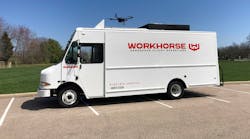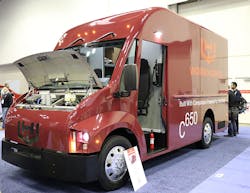Delivery vehicle manufacturer Workhorse has big plans for disrupting the last mile, which includes electric vans and perhaps even drones. Such lofty ambitions require an incredible amount of technical experience and collaboration, and the company based near Cincinnati has entered a strategic partnership with Hitachi America to acquire more of both. Through the multi-year agreement, Hitachi will thoroughly assess Workhorse’s manufacturing operations and supply chain, while also assisting in benchmarking to enhance production capabilities on the Workhorse C-Series all-electric step van.
"This alliance with Hitachi comes at an ideal time for Workhorse as we value their best in class innovation and experience in ramping up production and enabling us in providing a complete solution to our customers," said Workhorse CEO Duane Hughes. "With Hitachi's innovation and invaluable expertise in EV technology, smart factory automation and digital technologies, Workhorse is primed to build on our early leadership position as the only last-mile EV distributor selling vehicles for commercial use across the country. In addition, we believe Hitachi can help the Company drive customer orders as a well-known and respected player in the commercial leasing and finance industry, and we are looking forward to benefiting from their expertise."
Hughes previously noted that the C-Series was "only fully permitted, last-mile EV OEM with outstanding sales orders currently building vehicles for commercial use across the country."
Earlier this year, the C-Series won a Work Truck Show Innovation Award in the Green category. The van employs composites lighter than aluminum and features a 12,800-lb. GVWR. The C-Series includes three cubic-foot sizes: 650, 1,000 and 1,200. The battery range reaches 100 miles per charge with the four-module battery configuration and extends up to 150 miles per charge with the six-pack.
Through Ryder’s COOP peer-to-peer truck sharing platform, customers can lease or short-term rent the C-1000, starting in California, where at least two vehicles have been delivered.
Hitachi may be able to provide valuable insights into EV charging infrastructure, given its recent experience in that sector. In July, Hitachi ABB Power Grids (a joint venture between ABB and Hitachi) launched a solution for a fleet and mass transit charging system called Grid-eMotion Fleet.
In Japan, Hitachi also has invested in advancing drone technology for the freight/logistical sector. Hypothetically, if that business is ever brought over to the U.S., Workhorse may be able to leverage Hitachi’s Unmanned Aerial System Traffic Management system to keep its aerial delivery bots on course in crowded air space.
Last April, Workhorse paired with UPS to deliver medical supplies via drones. The drone is appropriately called the Horsefly and may be able to deliver 80% of most commercial package form factors and weights. The current model can carry 5 lb. for 10 miles.
For now, it appears Hitachi will help ground Workhorse’s strategies and roll out its zero-emission trucks.
"We are excited to partner with Workhorse to help accelerate the rollout of their EV solutions and meet growing customer demand in North America," said Hicham Abdessamad, chief executive of Hitachi Global Social Innovation Business and chairman of Hitachi America Ltd. "Hitachi is uniquely positioned in the growing commercial EV market with a set of innovative technologies and solutions to enable production capacity at scale, a reliable charging network infrastructure and a digital platform for intelligent vehicle routing and energy optimization. The Workhorse partnership is a strong testament to Hitachi's long-term commitment to Social Innovation."





